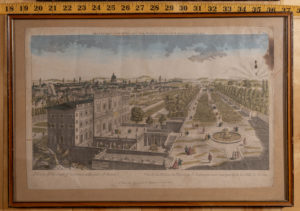 JF sent me three works on paper that hung in his domicile for years, and he doesn’t know what attracted him to them. Little did he know these peep show prints are a kin to the photography he earns his living from.
JF sent me three works on paper that hung in his domicile for years, and he doesn’t know what attracted him to them. Little did he know these peep show prints are a kin to the photography he earns his living from.
The sweeping perspective views and the primitive looking paint jobs fascinate him. He wonders about the phrases, some backwards.
I know the reason a person who makes his living with lenses loves these works on paper, even though he doesn’t know what they are. In the 1750s the lower middle classes viewed these in Paris carnivals through little wooden camera boxes. The boxes contained lenses and mirrors to enhance to perspective the view of each image. Gasps of amazement went up, as people only heard about these places, and never saw them.
His three Peep Show Prints:
 a view of the seat of Lodovisi, with part of Rome
a view of the seat of Lodovisi, with part of Rome - a Vue du Canal du Batiment Chinois
- Vue de l’hospital Jardins de Ranelagh, Greenwich, sur l’Thames
They aren’t expertly colored, and the ‘registration’ appears poor, meaning the printmaker rushed them through the print process. Also the paper quality seems cheap for the era. Meant as amusements, not works of art, they showed the unwashed carnival goers the travel views only the wealthy ever saw.
These views, in their little boxes mounted on boards at the fairs of Paris in the mid to late 18th century became wildly popular. A narrator regaled with tales of each view. Because they got some hard use, not many exist today and are worth about $400 each in the condition of JF’s prints.
You see the reversed title at the top naming the location. A central mirror sat in the cabinet built to house and show these prints through a peep hole. Viewing the image reflected by a mirror means the mirror doesn’t do the ‘flipping,’ the person’s eyes and brain does the flipping. An image reflected in a mirror bounces back, retraces its steps backwards, so the backwards titles printed on each of JF’s prints appeared right side up.
The Basset Family
The publisher’s address, as in most old prints from Paris, stated in the bottom left margin, points us to the family of successful printmakers. The Basset family stayed in business from 1720 to 1865. These predate images made and quickly colored for mass consumption (Currier and Ives) by decades. Basset was located in Paris’ famous street for printmaking and publishing, the Rue Saint Jacques. That street housed many engravers for a century, and became known for all levels of printmaking. These Peep Show prints owned by JF were the low-level work done quickly, for consumption by the uncultured.
Early forms of travel photography as well as optical images, these offered mainly perspective views. With tricks of lenses, mainly concave, the image could be flipped. A convex lens then ‘unflipped’ the image simulating real depth. The unwashed of Paris lined up to get a view of the Greenwich Hospital, for example. Something they’d never see, or a view of Rome, or a Chinese style pleasure house in the estate of a wealthy French Lord.
Other Peep Show Prints
Another version of Peep Show prints depicted devotional religious scenes, which elicited tears, some say. When you think of all the moving images we see on our PHONES today, you might feel as amazed as crowds in the mid to late 18th century by these fantastic prints. Just shows you how we ‘moderns’ are bombarded with imagery, like it or not.
Collectors exist for such examples of early optic imagery, and I put the set at $1,400. I find it a strange coincidence that a person such as JF, who didn’t identify these as early travel photography of sorts, loved them for years. History seems strange and images do haunt kindred spirits.